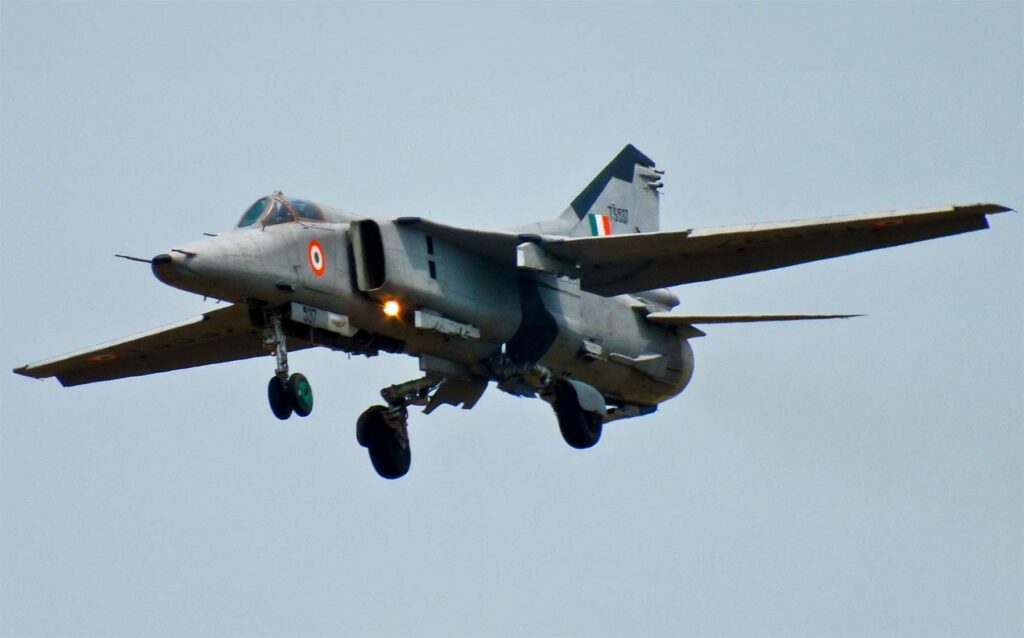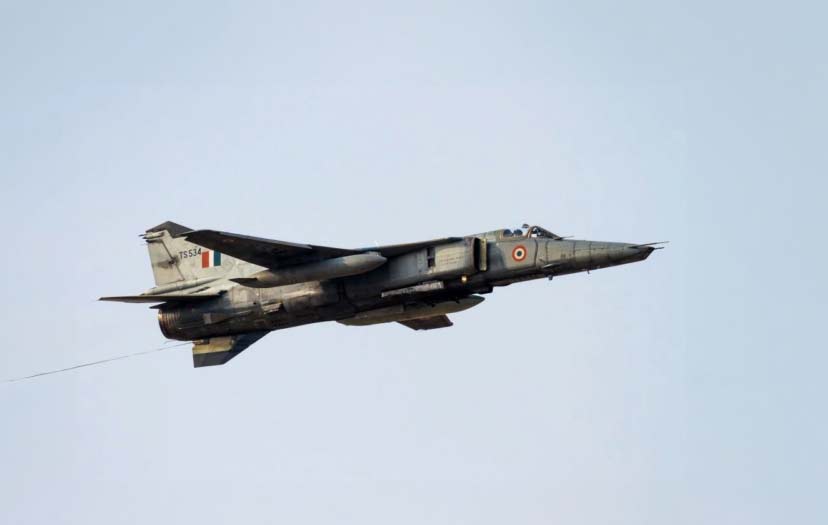Soviet-era ground attack aircraft with variable-geometry wings, designed for low-altitude strike missions.
In brief
The MiG-27, optimized from the MiG-23 for ground-attack, featured variable-sweep wings, a redesigned nose for improved pilot visibility, and a simplified, robust landing gear to handle rough field operations. Powered by a single jet engine, it was capable of carrying a large array of armaments including the formidable GSh-6-30 cannon. It was designed for durability and ease of maintenance, making it effective in rugged, frontline conditions.

History of the Development
Developed by the Mikoyan design bureau in the early 1970s, the MiG-27 was a derivative of the MiG-23, tailored specifically for air-to-ground missions. The need for such an aircraft arose from the Soviet military’s requirement for a more dedicated ground attack platform following experiences with earlier models like the MiG-23. The MiG-27’s design focused on low-level flight capabilities, payload capacity, and survivability in hostile environments. Its first flight occurred in 1972, and it entered service in 1975, quickly becoming a key asset for the Soviet Air Force.
Design of the Mikoyan MiG-27 (Flogger)
The MiG-27 retained the high-mounted variable-geometry wings of its predecessor but introduced a redesigned nose that lacked radar, reducing weight and enhancing the downward view, critical for its role in ground attacks. The cockpit was armored, and the aircraft featured a simpler engine air intake system and a rugged undercarriage to withstand operations from less developed runways. The wing structure allowed for three different sweep angles, adapting its aerodynamics for various flight profiles, from slow-speed loitering to high-speed escape.
Performance of the Mikoyan MiG-27 (Flogger)
Equipped with a Tumansky R-29 turbojet engine, the MiG-27 could reach speeds up to Mach 1.7, with a combat range of approximately 2,500 kilometers. It had a service ceiling of 14,000 meters and could carry up to 4,000 kg of mixed ordnance across seven hardpoints. Its performance was optimized for low-altitude penetration and strike missions, where high-speed and maneuverability at low levels were paramount.
Variants of the Mikoyan MiG-27 (Flogger)
The MiG-27 family included several variants like the MiG-27D, MiG-27M, and the advanced MiG-27K, each enhancing capabilities such as avionics, armaments, and survivability features. These variants offered improvements in navigation systems, weapons targeting, and electronic countermeasures, reflecting advancements in technology and operational feedback over its service life.

Military Use and Combat of the Mikoyan MiG-27 (Flogger)
During its service in the Soviet-Afghan War, the MiG-27 was pivotal in ground-attack operations. Its deployment was primarily driven by the need for effective close air support against Mujahideen forces, who were entrenched in Afghanistan’s complex and harsh terrain. The MiG-27, with its rugged design and powerful weaponry, was suited to the demanding conditions of the Afghan landscape. However, the aircraft faced significant risks from the Mujahideen’s increasing access to portable anti-aircraft weapons, such as the U.S.-supplied Stinger missiles. These weapons forced the MiG-27s to modify their tactics and fly at higher altitudes, which reduced the effectiveness of their ground-attack missions.
Post the dissolution of the Soviet Union, the MiG-27 continued to serve in the air forces of several countries, notably in India, where it remained active until 2019. In India, the MiG-27 was known locally as “Bahadur” (Valiant), and it played a critical role in various regional conflicts. The aircraft was notably used in the Kargil War in 1999, where it was employed to deliver laser-guided bombs, demonstrating its capability to perform precision strikes. The robustness of the MiG-27 was particularly appreciated in operations involving deep penetration and close air support, which were essential in mountainous terrains similar to those found in Kargil.
–
The MiG-27 Flogger was a significant development in Soviet aviation, focusing on the specific needs of ground-attack roles within the tactical air force structure. Its adaptability, robust design, and powerful armaments made it a valued asset in various international air forces, playing crucial roles in numerous military engagements across its operational history.
Back to the Fighter Jet section.